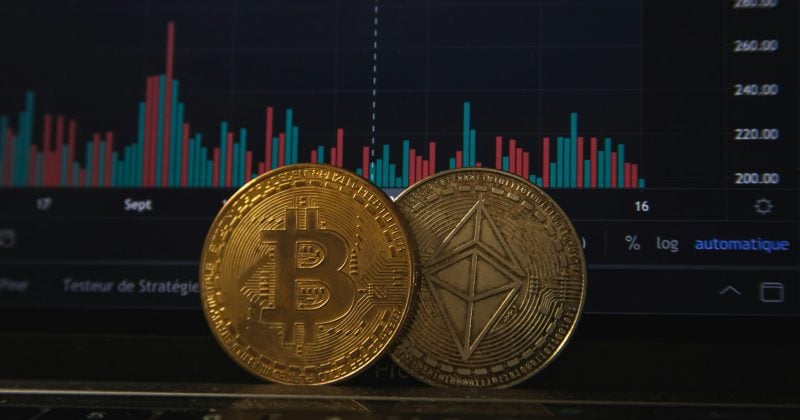Yield farming, or liquidity farming, is the act of lending or staking your cryptocurrency into a liquidity pool, through DeFi (Decentralized Finance) to receive rewards such as interest and more of their staked cryptocurrency. Similar to traditional staking, it can be seen as the equivalent of lending fiat money to a bank.
Interest rates or rewards rates are often measured in APY, which is the annual return rate of an asset, inclusive of compounding. The more frequently the interest compounds, the greater difference between the APY and APR of an investment. Banks and other more traditional investments usually stick to a flat APR.
Yield farming is often seen as the equivalent of Silicon Valley startups like Uber, which offer great incentives for early investors into the platform. New blockchain apps need liquidity to help sustain and eventually grow the platform, which is where yield farming steps in.
All staked cryptocurrency via yield farming is combined into a liquidity pool, usually for a specific pair of cryptocurrencies, such as CRO/ETH. These liquidity pools may be operated by Automatic Market Makers offering automated and permissionless trading tapping into liquidity pools instead of the generic buyers and sellers’ system.
When investing in a liquidity pool, users will receive a Liquidity Pool token to keep track of their overall contributions to the pool. This LP token will represent the percentage of the liquidity pool the investor has provided and will be exchanged when you exit the pool.
Fact: The word ‘farming’ in yield farming comes from the farming analogy about ‘growing’ your cryptocurrency.
What Is a Yield Farmer?
A crypto enthusiast with in-depth knowledge and a high tolerance for risk, continuously and relentlessly trying to optimize their yield by staking cryptocurrency. Yield farmers will often move to different pools every week, chasing the highest APY.
For example:
A yield farmer may make an initial investment into a farm using x token. They will receive some Y tokens for their participation.
They may then go and use their Y tokens on a liquidity pool that offers even more rewards, always trying to optimize their return.
How Does Yield Farming Work?
An investor will stake their cryptocurrency coins through a ‘lending protocol’ via a dApp (decentralized app on DeFi). Now that their liquidity is in, other investors can choose to borrow the liquidity for their own investments, trying to catch large swings in the staked coins’ price.
As yield farming is used to reward early investors, often governance tokens of that blockchain will be given out to keep them as a user, and their liquidity in the system.
Governance tokens help keep a project decentralized and allow real users to vote on any new legislature. Governance tokens are at the core of any DAO or project which aims to be fully run by its users.
Liquidity pools essentially keep the ecosystem alive and are where most of the early liquidity will come from in smaller projects.
What Are the Potential Rewards for Yield Farming?
Crypto yield farming first came available in 2020, and many yield farmers have bragged about triple-digit APY rates, unheard outside of the crypto space. However, these rates bring volatility. Often, the tokens received as rewards from such farms are extremely volatile and prone to rug pulls. We will dive deeper into the risks of yield farming later in the article.
You can find a full list of the most used and profitable yield farms, with daily and yearly APY here. CoinMarketCap simply views this as a resource and investors are recommended to do their own research before dipping their toes into the volatile world of yield farming.
Many crypto yield farms with low impermanent loss risk continue to hold double-digit yearly APYs, with niche coin pairs and riskier farms reaching triple and even quadruple-digit APY returns, unsustainable but profitable in the short term.
Although almost all crypto trading is speculation, to consistently profit from yield farming, high-level strategies are usually required and a decent chunk of change is often recommended, even as a beginner.
Liquidity Mining
Usually, a crypto yield farmer will receive interest for their stake based on the APY. However, liquidity mining is when the farmer also receives a new token on top of their existing interest as a thank you for participation.
Risks of Crypto Yield Farming
Like anything in a purely speculative market like cryptocurrency, a higher tolerance for risk than normal is usually required, yield farming is no exception. Yield-farming is done only on Decentralized Exchanges (DEX) which leads to a multitude of potential risks.
Rug Pulls
Rug pulls occur when the developers or founders of a cryptocurrency decide to abandon a project, usually unannounced, by pulling the project’s liquidity funded by investors. The investors keep their coins, but they are now worthless.
A rug pull is an exit scam, the founders have zero intention of returning to the project. Yield farmers are at a greater risk than normal to exit scams based on the type of startup cryptocurrency projects they are investing in, combined with the natural anonymity of crypto.
Smart Contract Bugs or Hacks
The most prominent risk in yield farming, smart contract risk occurs when bugs make the farmer’s funds vulnerable to being hacked or stolen.
Impermanent loss
During the stake, the farmer’s coins still follow the market value of that coin, meaning an investor can in theory lose a lot more than received through interest if their staked crypto drops a lot in value.
However, this can be argued that the farmer would not have sold even if they were not staking their coins, so at least they have gained some interest.
Volatility
On the same note as impermanent loss, dealing with extremely volatile cryptos can mean a skyrocket or plummet while your crypto is locked in a stake, and there’s nothing you can do about it until the coins are released.
What Are the Best Platforms for Yield Farming
The general go-to platforms for yield farming are any well-known decentralized exchanges that support dApps. Good examples would be:
- Uniswap
- Pancake swap
- Sushiswap
- 1inch Network
Please remember that DeFi has a much higher learning curve for new users than centralized exchanges, if mistakes are made, they can cost you dearly! Do your own research before jumping into any of these platforms!
1inch Network
The 1inch network is a great place for beginners to start their yield farming journey, as they pool the best rates and pools from all over the crypto sphere, meaning you will not have to manually hop around several different decentralized exchanges or dApps to find the best pools for you to provide liquidity.
1inch has a simple guide on how to start yield farming with them. You can find it here.
There is arguably no ‘best’ platform for yield farming. Each platform will allow yield farmers to operate on different chains, so doing your research before settling on one is your best bet.
Having a clear strategy before starting will allow the pieces to fall in place more smoothly and with less risk.
Is Yield Farming Worth It?
To be truly successful at crypto yield farming, you not only must have a working strategy in place to maximize your yield and the initial capital to invest, but you must also be passionate about making passive income, actively.
Although you can simply stake in safe pools, the spirit of yield farming is to chase the best possible yields.
The key takeaway to deciding whether yield farming is worth it to you is, what do you want? Yield farming, especially on chains such as Ethereum with high gas fees is only viable for those looking to invest a considerable sum, otherwise, your initial investment will get eaten by gas fees.
If you are not looking to invest a considerable amount of time learning strategies and finding the best pools, it may be better to try basic staking first and learning the basics, then graduate to become a yield farmer.
Final Thoughts
Ultimately, your risk tolerance will ultimately determine your success in yield farming. Those willing to micromanage their different farms constantly and tediously will make the biggest wins and bounce back from their losses the quickest
Yield farming is a great way for more experienced DeFi users to get stuck in and become part of the community, and something for new investors to look forward to, or simply dip their toes in.
FAQ
Is Yield Farming Profitable?
Crypto yield farming can be very profitable if properly executed, with numerous examples of individuals earning sizable gains since 2020. However, profits are dependent on volatility and should be properly understood, as well as any potential risks.
What is Yield Farming?
As is the case with traditional staking and rewards, crypto yield farming can be seen as the equivalent of lending fiat money to a bank. This technique is often seen as an incentive for early investors of a given platform. Many new blockchain apps require substantial liquidity to help sustain and eventually develop a project.
What is the Best Crypto to Yield Farm?
Users can familiarize themselves with many crypto yield farming platforms. Some of the largest include eToro and Crypto.com.
How Do You Earn Yield on Crypto?
An investor generally will stake their crypto coins via a ‘lending protocol’ such as dApp. By harnessing their own resources, additional investors can choose to borrow the liquidity for their own investments, thereby aiming to catch large swings in the staked coins’ price.
Yield farming, or liquidity farming, is the act of lending or staking your cryptocurrency into a liquidity pool, through DeFi (Decentralized Finance) to receive rewards such as interest and more of their staked cryptocurrency. Similar to traditional staking, it can be seen as the equivalent of lending fiat money to a bank.
Interest rates or rewards rates are often measured in APY, which is the annual return rate of an asset, inclusive of compounding. The more frequently the interest compounds, the greater difference between the APY and APR of an investment. Banks and other more traditional investments usually stick to a flat APR.
Yield farming is often seen as the equivalent of Silicon Valley startups like Uber, which offer great incentives for early investors into the platform. New blockchain apps need liquidity to help sustain and eventually grow the platform, which is where yield farming steps in.
All staked cryptocurrency via yield farming is combined into a liquidity pool, usually for a specific pair of cryptocurrencies, such as CRO/ETH. These liquidity pools may be operated by Automatic Market Makers offering automated and permissionless trading tapping into liquidity pools instead of the generic buyers and sellers’ system.
When investing in a liquidity pool, users will receive a Liquidity Pool token to keep track of their overall contributions to the pool. This LP token will represent the percentage of the liquidity pool the investor has provided and will be exchanged when you exit the pool.
Fact: The word ‘farming’ in yield farming comes from the farming analogy about ‘growing’ your cryptocurrency.
What Is a Yield Farmer?
A crypto enthusiast with in-depth knowledge and a high tolerance for risk, continuously and relentlessly trying to optimize their yield by staking cryptocurrency. Yield farmers will often move to different pools every week, chasing the highest APY.
For example:
A yield farmer may make an initial investment into a farm using x token. They will receive some Y tokens for their participation.
They may then go and use their Y tokens on a liquidity pool that offers even more rewards, always trying to optimize their return.
How Does Yield Farming Work?
An investor will stake their cryptocurrency coins through a ‘lending protocol’ via a dApp (decentralized app on DeFi). Now that their liquidity is in, other investors can choose to borrow the liquidity for their own investments, trying to catch large swings in the staked coins’ price.
As yield farming is used to reward early investors, often governance tokens of that blockchain will be given out to keep them as a user, and their liquidity in the system.
Governance tokens help keep a project decentralized and allow real users to vote on any new legislature. Governance tokens are at the core of any DAO or project which aims to be fully run by its users.
Liquidity pools essentially keep the ecosystem alive and are where most of the early liquidity will come from in smaller projects.
What Are the Potential Rewards for Yield Farming?
Crypto yield farming first came available in 2020, and many yield farmers have bragged about triple-digit APY rates, unheard outside of the crypto space. However, these rates bring volatility. Often, the tokens received as rewards from such farms are extremely volatile and prone to rug pulls. We will dive deeper into the risks of yield farming later in the article.
You can find a full list of the most used and profitable yield farms, with daily and yearly APY here. CoinMarketCap simply views this as a resource and investors are recommended to do their own research before dipping their toes into the volatile world of yield farming.
Many crypto yield farms with low impermanent loss risk continue to hold double-digit yearly APYs, with niche coin pairs and riskier farms reaching triple and even quadruple-digit APY returns, unsustainable but profitable in the short term.
Although almost all crypto trading is speculation, to consistently profit from yield farming, high-level strategies are usually required and a decent chunk of change is often recommended, even as a beginner.
Liquidity Mining
Usually, a crypto yield farmer will receive interest for their stake based on the APY. However, liquidity mining is when the farmer also receives a new token on top of their existing interest as a thank you for participation.
Risks of Crypto Yield Farming
Like anything in a purely speculative market like cryptocurrency, a higher tolerance for risk than normal is usually required, yield farming is no exception. Yield-farming is done only on Decentralized Exchanges (DEX) which leads to a multitude of potential risks.
Rug Pulls
Rug pulls occur when the developers or founders of a cryptocurrency decide to abandon a project, usually unannounced, by pulling the project’s liquidity funded by investors. The investors keep their coins, but they are now worthless.
A rug pull is an exit scam, the founders have zero intention of returning to the project. Yield farmers are at a greater risk than normal to exit scams based on the type of startup cryptocurrency projects they are investing in, combined with the natural anonymity of crypto.
Smart Contract Bugs or Hacks
The most prominent risk in yield farming, smart contract risk occurs when bugs make the farmer’s funds vulnerable to being hacked or stolen.
Impermanent loss
During the stake, the farmer’s coins still follow the market value of that coin, meaning an investor can in theory lose a lot more than received through interest if their staked crypto drops a lot in value.
However, this can be argued that the farmer would not have sold even if they were not staking their coins, so at least they have gained some interest.
Volatility
On the same note as impermanent loss, dealing with extremely volatile cryptos can mean a skyrocket or plummet while your crypto is locked in a stake, and there’s nothing you can do about it until the coins are released.
What Are the Best Platforms for Yield Farming
The general go-to platforms for yield farming are any well-known decentralized exchanges that support dApps. Good examples would be:
- Uniswap
- Pancake swap
- Sushiswap
- 1inch Network
Please remember that DeFi has a much higher learning curve for new users than centralized exchanges, if mistakes are made, they can cost you dearly! Do your own research before jumping into any of these platforms!
1inch Network
The 1inch network is a great place for beginners to start their yield farming journey, as they pool the best rates and pools from all over the crypto sphere, meaning you will not have to manually hop around several different decentralized exchanges or dApps to find the best pools for you to provide liquidity.
1inch has a simple guide on how to start yield farming with them. You can find it here.
There is arguably no ‘best’ platform for yield farming. Each platform will allow yield farmers to operate on different chains, so doing your research before settling on one is your best bet.
Having a clear strategy before starting will allow the pieces to fall in place more smoothly and with less risk.
Is Yield Farming Worth It?
To be truly successful at crypto yield farming, you not only must have a working strategy in place to maximize your yield and the initial capital to invest, but you must also be passionate about making passive income, actively.
Although you can simply stake in safe pools, the spirit of yield farming is to chase the best possible yields.
The key takeaway to deciding whether yield farming is worth it to you is, what do you want? Yield farming, especially on chains such as Ethereum with high gas fees is only viable for those looking to invest a considerable sum, otherwise, your initial investment will get eaten by gas fees.
If you are not looking to invest a considerable amount of time learning strategies and finding the best pools, it may be better to try basic staking first and learning the basics, then graduate to become a yield farmer.
Final Thoughts
Ultimately, your risk tolerance will ultimately determine your success in yield farming. Those willing to micromanage their different farms constantly and tediously will make the biggest wins and bounce back from their losses the quickest
Yield farming is a great way for more experienced DeFi users to get stuck in and become part of the community, and something for new investors to look forward to, or simply dip their toes in.
FAQ
Is Yield Farming Profitable?
Crypto yield farming can be very profitable if properly executed, with numerous examples of individuals earning sizable gains since 2020. However, profits are dependent on volatility and should be properly understood, as well as any potential risks.
What is Yield Farming?
As is the case with traditional staking and rewards, crypto yield farming can be seen as the equivalent of lending fiat money to a bank. This technique is often seen as an incentive for early investors of a given platform. Many new blockchain apps require substantial liquidity to help sustain and eventually develop a project.
What is the Best Crypto to Yield Farm?
Users can familiarize themselves with many crypto yield farming platforms. Some of the largest include eToro and Crypto.com.
How Do You Earn Yield on Crypto?
An investor generally will stake their crypto coins via a ‘lending protocol’ such as dApp. By harnessing their own resources, additional investors can choose to borrow the liquidity for their own investments, thereby aiming to catch large swings in the staked coins’ price.
















